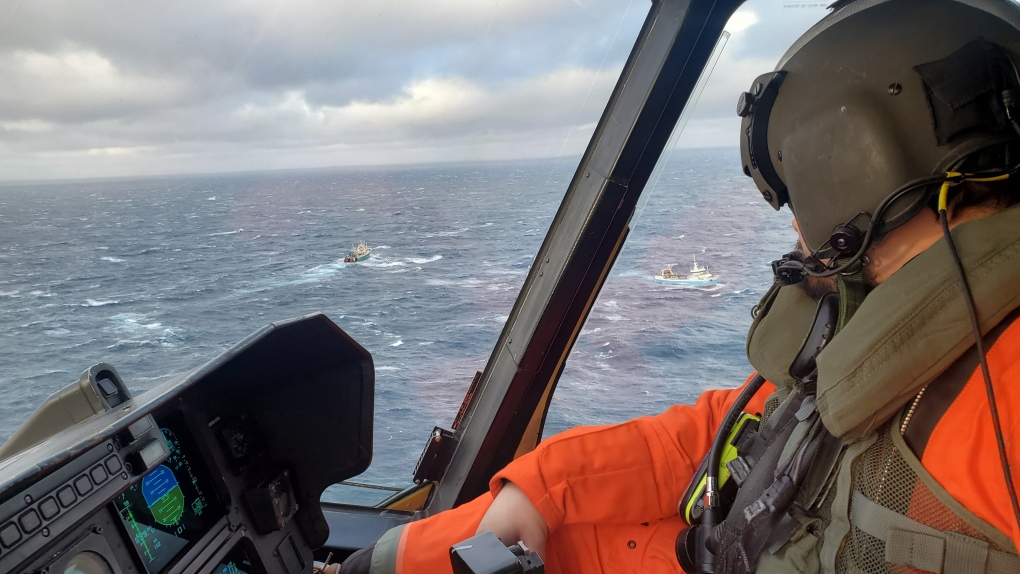Tragedy at Sea
"Our thoughts go out to all the families of this crew [capsized Spanish fishing trawler 50-metre Villa de Pitanxo.""One of the advantages overnight is you can potentially spot flares or strobe lights. It has allowed us to focus our efforts and centralize our search.""The visibility has decreased with fog so it is making it a little bit challenging on the water.""I've seen 10- to 15-metre swells. Five to five-and-a-half [metres] is still a bit of a rough ride, depending on the type of vessel you are in. The Spanish fishing vessels that are assisting in this search are designed for this weather."Lt.Cmdr. Brian Owens, spokesman, Joint Rescue Coordination Centre, Halifax
 | ||
| Spanish fishing vessel sank on Tuesday off Newfoundland Coast |
The Spanish port town of Marin in northwestern Galicia is in mourning. Many of its residents make their living fishing in the deep, dangerous waters of the Atlantic. The sinking of the fishing trawler and the confirmed loss of ten fishermen's lives represents the biggest tragedy it has suffered on record. The total crew on the vessel of 24 has not yet been accounted for.
Three survivors were found -- by another Spanish fishing boat that had responded to the first distress signal received after midnight on Tuesday -- rescued from their life raft. Which leaves nine crew whose fate has yet to be officially accounted for as the search continued.
The area, 460 kilometres east of St.John's, Newfoundland is being conducted largely by the Halifax-based Joint Rescue Coordination Centre. There was some initial question whether the survivors would be brought to St.John's for medical treatment, or shipped directly back to Spain. In the interim they are being cared for by the members of the crew that rescued them. Their condition was unknown.
 |
| Search aircraft over the Atlantic near Newfoundland The Canadian Press |
A debris field was located earlier in the day in the North Atlantic. According to Lt.Cmdr. Owens, some life-jackets, fishing equipment, gear and an empty life-raft were discovered floating about at the site. Search teams were faced with dangerous sea conditions; the region experiencing 74-kilometre-per-hour winds and 5.5-metre sea swells. In that area of the North Atlantic conditions can be even fiercer at times.
Three Cormorant helicopters were rotating in and around the area, flying from St.John's to the Hibernia offshore oilfield and then out to the search site. A provincial airlines aircraft and a C130 Hercules out of Greenwood, Nova Scotia were conducting sensor sweeps. "A number" of Spanish fishing ships have been on scene, assisting, and the Canadian Coast Guard vessel Cygnus was en route to the debris site where the Villa de Pitanxo sank at roughly 1 a.m. Eastern Time in rough seas.

"This is the end of an active [36-hour] search. All vessels, all aircraft that were participating in this search and rescue have been returned to home base.""The conditions have been extremely difficult with 10 metre seas, 45-knot winds, and visibility down below three nautical miles.""It’s been extremely challenging for them to continue that search."Lt.-Cmdr. Brian Owens"There’s probably between 10 and 15 vessels out there at this time of year, despite the conditions of course.""Most of these vessels are large bottom trawlers, they are obviously pulling a lot of weight, assuming their nets are fairly full.""And obviously in very, very rough seas."Fred Kingston, executive secretary, Northwest Atlantic Fisheries Organization
Labels: Fishing Trawlers, Newfoundland, North Atlantic, Search and Rescue, Spanish Vessel, Tragedy

0 Comments:
Post a Comment
<< Home